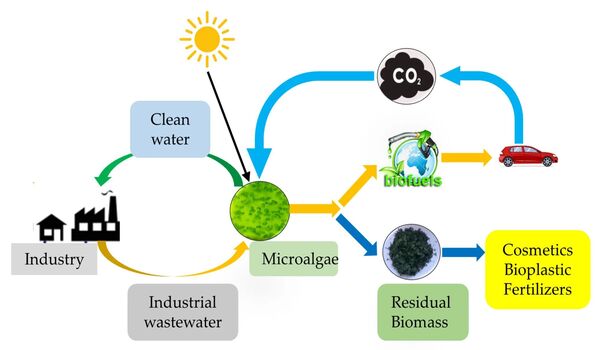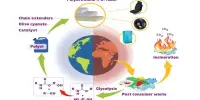When it comes to producing fuel from plants, the first step has always been the most difficult: breaking down plant materials. A new study discovers that adding a simple, renewable chemical to the pretreatment phase can finally make next-generation biofuel manufacturing cost-effective and carbon neutral.
For biofuels to compete with petroleum, biorefinery operations must be designed to make better use of lignin. Lignin is a key component of plant cell walls. It increases plant structural integrity and resilience to microbial attacks. However, the intrinsic characteristics of lignin make it difficult to extract and use from plant materials, often known as biomass.
“Lignin utilization is the gateway to making what you want out of biomass in the most economical and environmentally friendly way possible,” said UC Riverside Associate Research Professor Charles Cai. “Designing a process that can better utilize both the lignin and sugars found in biomass is one of the most exciting technical challenges in this field.”
To overcome the lignin hurdle, Cai invented CELF, which stands for co-solvent enhanced lignocellulosic fractionation. It is an innovative biomass pretreatment technology.
CELF uses tetrahydrofuran or THF to supplement water and dilute acid during biomass pretreatment. It improves overall efficiency and adds lignin extraction capabilities. Best of all, THF itself can be made from biomass sugars.
Professor Charles Cai
“CELF uses tetrahydrofuran or THF to supplement water and dilute acid during biomass pretreatment. It improves overall efficiency and adds lignin extraction capabilities,” Cai said. “Best of all, THF itself can be made from biomass sugars.”
A seminal Energy & Environmental Science publication describes how a CELF biorefinery outperforms petroleum-based fuels and previous biofuel production technologies in terms of both economics and the environment.
The paper is a cooperation between Cai’s UCR research team, Oak Ridge National Laboratories’ Center for Bioenergy Innovation, and the National Renewable Energy Laboratory, with funding from the United States Department of Energy’s Office of Science. In it, the researchers address two major variables: what type of biomass is best, and what to do with the lignin once removed.
First-generation biofuel operations use food crops like corn, soy, and sugarcane as raw materials, or feedstocks. Because these feedstocks divert land and water away from food production, using themfor biofuels is not ideal.
Second-generation operations use non-edible plant biomass as feedstocks. An example of biomass feedstocks includes wood residues from milling operations, sugarcane bagasse, or corn stover, all of which are abundant low-cost byproducts of forestry and agricultural operations.

According to the Department of Energy, up to a billion tons of biomass may be made accessible each year for the production of biofuels and bioproducts in the United States alone, substituting 30% of our petroleum usage while creating new domestic jobs. Because a CELF biorefinery can better utilize plant matter than previous second-generation technologies, the researchers discovered that a heavier, denser feedstock, such as hardwood poplar, is preferred to less carbon-dense maize stover for greater economic and environmental benefits.
Using poplar in a CELF biorefinery, the researchers demonstrate that sustainable aviation fuel could be made at a break-even price as low as $3.15 per gallon of gasoline equivalent. The current average cost for a gallon of jet fuel in the U.S. is $5.96.
The U.S. government issues credits for biofuel production in the form of renewable identification number credits, a subsidy meant to bolster domestic biofuel production. The tier of these credits issued for second-generation biofuels, the D3 tier, is typically traded at $1 per gallon or higher. At this price per credit, the paper demonstrates that one can expect a rate of return of over 20% from the operation.
“Spending a little more for a more carbon-rich feedstock like poplar still yields more economic benefits than a cheaper feedstock like corn stover, because you can make more fuel and chemicals from it,” Cai said.
The paper also illustrates how lignin utilization can positively contribute to overall biorefinery economics while keeping the carbon footprint as low as possible. In older biorefinery models, where biomass is cooked in water and acid, the lignin is mostly unusable for more than its heating value.
“The older models would elect to burn the lignin to supplement heat and energy for these biorefineries because they could mostly only leverage the sugars in the biomass — a costly proposition that leaves a lot of value off the table,” Cai added.
In addition to enhanced lignin usage, the CELF biorefinery model proposes producing renewable chemicals. These molecules could be utilized to make bioplastics, as well as flavoring compounds for food and beverages. These compounds absorb some of the carbon in plant biomass that would not otherwise be released into the environment as CO2.
“Adding THF reduces the energy cost of pretreatment and isolates lignin, eliminating the need to burn it. Furthermore, we can produce renewable chemicals that will help us achieve a near-zero global warming potential,” Cai explained. “I think this moves the needle from Gen 2 biofuels to Gen 2+.”
In recognition of the team’s recent results, the Department of Energy’s Bioenergy Technology Office has offered the researchers a $2 million grant to construct a small-scale CELF pilot plant at UCR. Cai thinks that proving the pilot plant would lead to larger-scale investment in the technology, as generating energy from fossil fuels contributes to global warming and harms the environment.
















